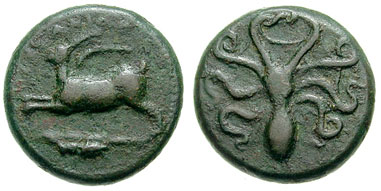AC 71 - Messana, bronze, tetrantes (407/6-396 BCE)
From SILVER
407 BCE - 396 BCE Bronze
Description
| ObverseInscription or printing placed on the obverse.: | MEΣΣANIΩN (Greek).Hare running left, lagabolon above, locust right n exergue |
| ReverseInscription or printing placed on the reverse.: | Cuttlefish |
Mint and issuing power
| MintIdentifies the place of manufacture or issue of a numismatic object.: | Messana | Ancient regionAncient region.: | Sicily | Modern countryModern country: Italy | AuthorityIdentifies the issuing power. The authority can be "pretended" when the name or the portrait of X is on the coin but he/she was not the issuing power. It can also be "uncertain" when there is no mention of X on the coin but he/she was the issuing power according to the historical sources: |
Chronology
| FromIdentifies the initial date in a range assigned in a numismatic context. | 407 BCE | toIdentifies the final date in a range assigned in a numismatic context.. | 396 BCE | PeriodTime period of the numismatic object.: Classical 480-323 BC |
Physical description
| MetalThe physical material (usually metal) from which an object is made.: | Bronze |
Median weightMedian of the weights of numismatic objects (in grams). in grams | 6.50 | DenominationTerm indicating the value of a numismatic object. Examples: tetradrachm, chalkous, denarius.: | tetras | StandardStandard.: |
Image

AC 71 - Messana, bronze, tetrantes (407-6-396 BCE).jpg [1]
References
| Die study referencePublication of the study: | Caccamo Caltabiano 19931Caccamo Caltabiano 1993, n° 686-708. | ||
| Coin series referenceReference to coin series study: | Sear I2Sear I, n° 1132, RQEMAC3RQEMAC, n° 71, HGC 24HGC 2, n° 832 | ||
Obverse dies distribution
| FrequencyFrequency of specimen in distribution. ᵖ | Number of obversesNumber of obverse dies. ᵖ (o) | % (o) | Number of coinsNumber of coins. (n) | % (n) | Die nameName(s) of the die(s). |
| 1 | 1 | 6.67 | 1 | 1.3 | 7 |
| 2 | 3 | 20 | 6 | 7.79 | 8, 9, 13 |
| 3 | 1 | 6.67 | 3 | 3.9 | 15 |
| 4 | 3 | 20 | 12 | 15.58 | 5, 10, 12 |
| 5 | 1 | 6.67 | 5 | 6.49 | 4 |
| 6 | 2 | 13.33 | 12 | 15.58 | 6, 11 |
| 7 | 2 | 13.33 | 14 | 18.18 | 2;14 |
| 12 | 2 | 13.33 | 24 | 31.17 | 1, 3 |
| Total | 15 of 15 | 100 | 77 of 77 | 99.99 |
Reverse dies distribution
no distribution is available
Quantification
| Number of obversesNumber of obverse dies. ᵖ (o) | 15 | Number of singletons (o1)The number of singleton coins. ᵖ | 1 |
| Number of reverse diesNumber of reverse dies. (r) | 21 | Number of coinsNumber of coins. (n) | 77 |
| Coins per obverse dieNumber of coins per obverse die. (n/o) | 5.13 | Coins per reverse dieNumber of coins per reverse die. (n/r) | 3.67 |
| Reverse per obverse ratioRatio of obverse dies divided by reverse dies. (r/o) | 1.4 | Percentage of singletons (o1)number of coins (n) divided by the number of singletons (o1) ᵖ | 6.67 % |
| Original number of dies (O) (Carter 1983 formula)The estimation of the number of coins according to Carter 1983 ᵖ | 16.58 | Coins struck if 20,000 as average productivity per dieCoins made if the average productivity for obverses (according to Carter) is 20,000. ᵖ | 331,600 |
| Original number of dies (O) (Esty 2011 formula)The estimation of the number of coins according to the singleton formula in Esty 2011 ᵖ (O) | 18.63 | Survival rate if 20,000 as average productivity per dieSurvival rate if average productivity is 20,000. ᵖ | 0.00023 |
| Coverage (o = % of O) (Esty 1984 formula)Esty 1984 - coverage (% of O) ᵖ (o = % of O) | 98.7% | Die productivity if survival rate 1/2,000Average productivity if survival rate is 1/2,000. ᵖ | 9,288.3 |
| Weight of silver (in kg) if 20,000 coins per die (O = Carter formula)Carter 1983 * Median weight * 20000 (*10 if gold or electrum) ᵖ | n.a. | Die productivity if survival rate 1/5,000Average productivity if survival rate is 1/5,000. ᵖ | 23,220.75 |
Remarks
Most likely one single workstation